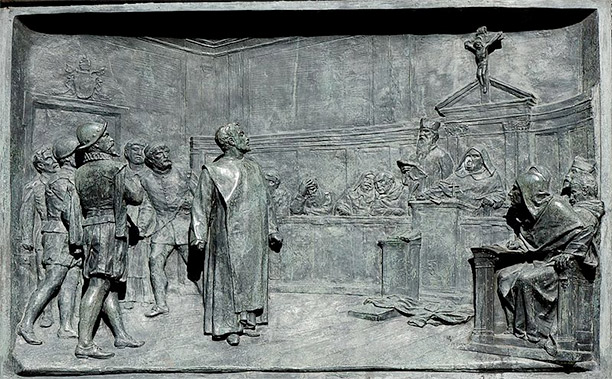Joyce among the heretics: Bruno, Joyce and Lacan

The Renaissance philosopher Giordano Bruno, burned at the stake by the Roman Inquisition in 1600, was one of the figures of rebellion that Joyce chose as a model. To “choose” already spells out “heresy,” even if Joyce’s heresy followed a different path, a path that can be traced in the early prose works. Jacques Lacan, too, felt and stated that he was a “heretic” in the field of psychoanalysis, especially after he had been expelled from its main institutions. Lacan would quote Bruno regularly about the concept of an all-consuming desire.
Bruno, Joyce and Lacan, all three identified as “heretics” when refusing to bow down to the authority of institutions like the Catholic church, Irish nationalism, British imperialism, or the revisionist psychoanalytic doxa dominant in the International Psychoanalytic Association after the death of Freud. For Bruno, the revolutionary jolt came from the discovery of the infinity of worlds, for Joyce it was an utopia of textual infinity linked with a new writing capable of expressing absolutely everything, and for Lacan a new logic of language reduced to its signifiers that entailed breaking with reductive psychoanalytic theories of the “ego” that forgot Freud’s sharpest insights and concepts.
Even though Joyce changed his mind over time about Bruno’s philosophy as being monist or dualist, Bruno should not be reduced to the “coincidence of contraries” underpinning the technique of the portmanteau-words of Finnegans Wake. In fact, his De Vinculis launched a theory of ”binding” and of “knots” that anticipates the picture of Joyce given by Lacan as an artist inscribed in a complex Borromean knot called the “Sinthome.” Going from Bruno to Lacan via Joyce, one understands how the artist appears as an “ego scriptor” who writes and is written thanks to a new Symptom, a knot rebinding the three rings of the Real, the Symbolic and the Imaginary, changing the already heretic trinity of R,S,I, by adding the fourth ring of the Sigma (S), or the Sinthome.
Jean- Michel Rabaté is Professor of English and Comparative Literature at the University of Pennsylvania since 1992. He has authored or edited 48 books on modernism, psychoanalysis, contemporary art, philosophy, and writers like Beckett, Pound and Joyce. More recent titles include Rust (2018), Kafka L.O.L. (2018), After Derrida (2018), Rire au Soleil (2019), Understanding Derrida / Understanding Modernism (2019), Knots: Post-Lacanian Readings of literature and film (2020), Beckett and Sade (2020), Rires Prodigues (2021), Knots, Post-Lacanian readings of film, literature and culture, New York, Routledge, 2020, Beckett and Sade, Cambridge, Cambridge University Press, 2020. Rires Prodigues: Rire et jouissance chez Marx, Freud et Kafka, Paris, Stilus, 2021., With Angeliki Spiropoulou, Historical Modernisms: Time, History and Modernist Aesthetics, Bloomsbury, 2022 and James Joyce, Hérétique et Prodigue, Paris, Stilus, 2022.

